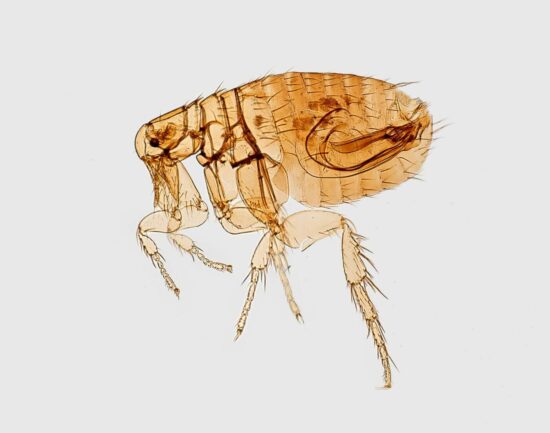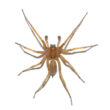Dealing with fleas can make any pet parent feel frustrated and overwhelmed. These tiny jumping bugs seem to appear out of nowhere and make life miserable for both pets and families. While pet stores are full of chemical treatments, many people want to try gentler, more natural solutions first.
Apple cider vinegar has become a popular home remedy that pet owners turn to when fighting fleas. This common kitchen ingredient might help keep these pesky bugs away from furry friends, though it’s important to understand what it can and cannot do.
While Apple cider vinegar doesn’t actually kill fleas, it can work as a natural repellent. The strong smell and acidic nature of vinegar can make pets less appealing to fleas. Learning how to use apple cider vinegar for fleas involves understanding several different methods, from spraying pets to cleaning carpets.
This guide covers seven different ways people use apple cider vinegar to fight fleas. Before trying any home remedy, talk with a veterinarian first. Natural methods work slower than store-bought products, so patience is key.
1. Making an Apple Cider Vinegar Spray for Pets
Creating a simple spray is probably the most popular way of using apple cider vinegar for fleas. This method creates an acidic environment on the pet’s fur that fleas tend to avoid.
To make the spray, mix equal parts raw, organic apple cider vinegar with water in a clean spray bottle. For example, use one cup of vinegar with one cup of water. Some people like to add 2-3 drops of pet-safe essential oils like lavender or lemongrass to make the smell more pleasant.
When applying the spray, focus on areas where fleas like to hang out. The neck, back, and base of the tail are common spots. Always avoid spraying near the eyes, nose, and ears, as vinegar can sting and cause irritation.
This spray works best when used before pets go outside, especially during flea season. Many pet owners apply it daily as a preventive measure. The acidic smell may help keep fleas from jumping onto pets in the first place.
No products found.
Safety is crucial when using this method. Never use undiluted apple cider vinegar directly on pets, as it can burn their skin. Always test a small area first to make sure the pet doesn’t have a bad reaction. If any redness, scratching, or irritation appears, stop using the spray right away.
Some pets don’t mind the spray, while others hate the smell and try to run away. Start slowly and let pets get used to the scent. If a pet seems stressed or uncomfortable, this method might not be the best choice.
2. Adding Apple Cider Vinegar to Your Pet’s Water
Some people believe that adding vinegar to drinking water can help fight fleas from the inside out. The idea is that it changes the pet’s body chemistry, making them less tasty to fleas.
For dogs, the general guideline is 1-2 tablespoons of apple cider vinegar per quart of water. For smaller cats, start with just 1/4 teaspoon. These amounts should be considered starting points, and it’s important to use even less if the pet refuses to drink.
However, this method comes with serious warnings. Many pets hate the taste of vinegar and will avoid their water bowl completely. This can lead to dehydration, which is much more dangerous than having fleas.
Veterinarians generally don’t recommend this approach. Forcing pets to drink vinegar can cause stomach upset, vomiting, and diarrhea. In extreme cases, if pets aspirate the liquid into their lungs, it could cause pneumonia.
If trying this method, watch the pet’s water consumption carefully. If they drink less than usual or seem to avoid their bowl, remove the vinegar immediately. Never force a pet to drink anything they don’t want.
The risks of this method often outweigh any potential benefits. Most experts suggest sticking to external applications rather than adding vinegar to food or water.
3. Giving Pets an Apple Cider Vinegar Bath
Bath treatments can be helpful for pets that already have fleas, especially young puppies or kittens who are too small for commercial flea medications. This method combines the cleaning power of soap with the potential repellent effects of vinegar.
To prepare the bath, fill the tub with comfortably warm water and add about 2 cups of apple cider vinegar. Many people also add Dawn dish soap, which can actually drown fleas on contact. The combination might be more effective than using vinegar alone.
Start by wetting the pet thoroughly, then apply the soap and vinegar mixture. Work it into the fur, paying special attention to areas where fleas like to hide. Let the mixture sit for 5-10 minutes before rinsing. Some people choose not to rinse completely, leaving a light vinegar residue on the fur.
During the bath, dead fleas may fall into the water. This is actually a good sign that the treatment is working. After the bath, use a fine-tooth flea comb to remove any remaining fleas or flea dirt.
This method works best as part of a larger flea control plan. While it might kill some fleas and make the pet less appealing to new ones, it won’t solve a serious infestation on its own.
Bath treatments are generally safer than other methods since the vinegar gets diluted in water. However, pets with sensitive skin might still experience irritation, so it’s important to watch for any signs of discomfort.
4. Cleaning Carpets and Furniture with Vinegar
Fleas don’t just live on pets. They also hide in carpets, upholstery, pet bedding, and along baseboards. Treating these areas is a crucial part of understanding how to use apple cider vinegar for fleas effectively.
For basic carpet cleaning, mix equal parts white vinegar (which is cheaper than apple cider vinegar for this purpose) with water in a spray bottle. For a stronger solution, try mixing 1 cup of white vinegar with 1 cup of water and 1 teaspoon of salt.
Before spraying large areas, test the solution on a small, hidden spot to make sure it won’t stain or damage the fabric. Once it’s safe to proceed, spray the mixture thoroughly on carpets, furniture, and other areas where pets spend time.
Pay special attention to pet sleeping areas, as these spots often have the highest concentrations of flea eggs and larvae. The acidic environment created by vinegar may help kill some of these developing fleas.
After spraying, let the solution air dry completely. This usually takes several hours. Once dry, vacuum the area thoroughly to remove dead fleas and eggs. The vacuuming step is just as important as the vinegar treatment.
This environmental treatment works best when done regularly. Fleas have a life cycle that can take weeks to complete, so one-time treatments rarely solve the problem completely. Many people repeat this process weekly during flea season.
5. Applying Vinegar as a Spot Treatment
Spot treatments allow for more precise application of vinegar to specific problem areas. This method gives pet owners better control over where the vinegar goes and reduces the risk of getting it in sensitive areas like eyes and ears.
To create a spot treatment, mix apple cider vinegar with water in a 50/50 ratio. Instead of using a spray bottle, apply the mixture with a cotton ball or soft cloth. This method works particularly well for the back of the neck, where many flea collars are placed.
The spot treatment approach is especially good for cats, who often hate being sprayed with anything. It’s also useful for nervous or squirmy pets who won’t sit still for a full spray treatment.
/short
No products found.
Focus on areas where fleas are most likely to gather. Besides the neck, check around the base of the tail, behind the ears, and on the belly. These warm, protected spots are flea favorites.
This method can be used daily for prevention or whenever fleas are spotted. Because the application is so targeted, there’s less risk of skin irritation compared to spraying the entire pet.
Always avoid putting vinegar on open wounds, cuts, or irritated skin. The acid can cause pain and delay healing. If a pet has been scratching a lot, check for broken skin before applying any vinegar treatment.
6. Mixing Vinegar with Other Natural Ingredients
Using apple cider vinegar for fleas can be more effective when combined with other natural ingredients. These combinations might work better than vinegar alone, though they still can’t match the power of commercial flea treatments.
One promising combination is apple cider vinegar with diatomaceous earth. Research shows that when these two ingredients are used together, they can kill up to 95% of flea larvae. Sprinkle food-grade diatomaceous earth on carpets, then follow with a vinegar spray treatment.
- Kills fleas, ants, roaches, and more
- Includes powder duster for easy, targeted application
- Works indoors and outdoors, long-lasting when dry
- 100% pure, food-grade, safe around pets and kids
Mixing vinegar with Dawn dish soap creates another powerful combination. The soap drowns fleas while the vinegar may repel new ones. This mixture works well for both baths and environmental cleaning.
Adding citrus juice to vinegar creates a double acidic effect that fleas seem to hate even more. Mix equal parts apple cider vinegar, water, and fresh lemon juice for a stronger repellent spray. The lemon also helps mask some of the vinegar smell.
For carpet treatments, combining vinegar with salt can be effective. The salt acts as a natural desiccant, drying out flea eggs and larvae, while the vinegar creates an unwelcome acidic environment.
When mixing ingredients, always research each one to make sure it’s safe for pets. Some essential oils and other natural products can be toxic to cats and dogs, even if they seem harmless.
Start with small amounts when trying new combinations. Even natural ingredients can cause reactions in sensitive pets. If any irritation occurs, stop the treatment immediately and consult a veterinarian.
7. Creating a Long Term Prevention Plan
The most successful approach to using apple cider vinegar for fleas involves creating a consistent prevention routine rather than just treating problems after they start. This ongoing strategy can help keep flea populations under control naturally.
A good weekly routine might include a light vinegar spray before outdoor activities, regular grooming with a flea comb, and environmental treatments of pet sleeping areas. During peak flea season (warm, humid months), increase the frequency of treatments.
Timing matters when it comes to prevention. Apply vinegar sprays before pets go outside, especially to areas like dog parks, beaches, or wooded areas where fleas are common. The goal is to make pets less appealing to fleas before they encounter them.
Combine vinegar treatments with other natural prevention methods for better results. Regular vacuuming removes flea eggs from carpets. Washing pet bedding in hot water kills fleas at all life stages. Keeping grass short and removing debris from yards reduces flea hiding spots.
Track how well the prevention plan is working by monitoring flea activity levels. If fleas start appearing despite regular treatments, it might be time to adjust the routine or consider stronger interventions.
Remember that natural prevention takes patience and consistency. Unlike commercial flea preventatives that work immediately, vinegar treatments build up their effectiveness over time. Stick with the routine for several weeks before deciding if it’s working.
Important Safety Information Every Pet Owner Should Know
While apple cider vinegar is generally considered safer than chemical flea treatments, it’s not risk-free. Understanding the potential side effects helps pet owners make informed decisions about whether these treatments are right for their animals.
Skin irritation is the most common problem with vinegar treatments. Some pets develop contact dermatitis, which shows up as redness, itching, or small bumps on the skin. This is more likely to happen with undiluted vinegar or in pets with sensitive skin.
If pets lick vinegar off their fur, they might experience digestive upset. Small amounts of diluted vinegar usually aren’t harmful, but larger quantities can cause vomiting, diarrhea, and stomach pain. Pets should never be forced to consume vinegar in any form.
Respiratory problems can occur if vinegar is inhaled, especially in pets with asthma or other breathing issues. When spraying vinegar solutions, make sure there’s good ventilation and avoid creating fine mists that pets might breathe in.
Certain pets should avoid vinegar treatments completely. Very young puppies and kittens have more sensitive skin that can be easily burned. Pets with open wounds, cuts, or existing skin conditions shouldn’t be treated with acidic solutions.
Most veterinarians recommend proven flea preventatives over home remedies. While some pets do seem to benefit from vinegar treatments, the scientific evidence for their effectiveness is limited. Commercial flea products undergo extensive testing and are designed to kill fleas at all life stages.
Signs that vinegar treatment should be stopped immediately include excessive scratching, skin redness, behavioral changes, or worsening flea infestations. If any of these problems occur, contact a veterinarian for advice.
What the Science Says About Vinegar and Fleas
Research on how to use apple cider vinegar for fleas shows mixed results. While some studies suggest vinegar can kill fleas under certain conditions, the real-world effectiveness is often disappointing.
A 2014 study found that white vinegar could kill 100% of adult fleas after 18 hours of direct exposure. However, this study was done in laboratory conditions that don’t match how vinegar is actually used on pets. The vinegar was applied directly to fleas in containers, not sprayed on animals.
The same research showed that vinegar was much less effective against flea eggs and pupae (the cocoon stage). Since these stages make up about 60% of the flea population in an infested home, treatments that only work on adult fleas have limited impact.
Vinegar’s main benefit appears to be as a repellent rather than a killer. The strong smell and acidic pH may discourage fleas from staying on treated pets. However, this effect is temporary since vinegar evaporates quickly from fur.
Most veterinary sources are skeptical about vinegar’s effectiveness. Professional veterinarians point out that modern flea preventatives are much more reliable and work continuously for weeks or months. Home remedies like vinegar require constant reapplication and still might not solve serious infestations.
Pest control experts have similar concerns. While they acknowledge that some natural methods can provide minor benefits, they emphasize that severe flea problems usually require professional-grade treatments.
The bottom line is that vinegar might help as part of a comprehensive flea management strategy, but it shouldn’t be the only tool used. Pet owners dealing with serious infestations will likely need stronger interventions.
When Natural Methods Aren’t Enough
Sometimes, despite best efforts with natural treatments, flea problems persist or get worse. Knowing when to seek professional help can save pets from prolonged discomfort and prevent infestations from spreading throughout the home.
Signs that stronger intervention is needed include multiple pets being affected, family members getting bitten, or pets showing signs of flea allergy dermatitis. This skin condition causes intense itching, hair loss, and small red bumps that can become infected from scratching.
Young puppies, kittens, and small pets are at risk for anemia if flea infestations become severe. Fleas can consume up to 15 times their body weight in blood daily, which can be dangerous for small animals. Signs of anemia include pale gums, weakness, and lethargy.
Severe infestations often require professional pest control services that can treat both pets and the environment simultaneously. These companies have access to stronger treatments that can break the flea life cycle more effectively than home remedies.
Veterinary flea preventatives are designed to kill fleas within hours of contact and provide protection for weeks or months. Popular options include oral medications, topical treatments, and flea collars. While these products contain chemicals, they’re extensively tested for safety and effectiveness.
The key is finding the right balance between natural and conventional treatments. Some pet owners successfully use vinegar as a supplementary tool alongside veterinary preventatives, especially during peak flea season.



